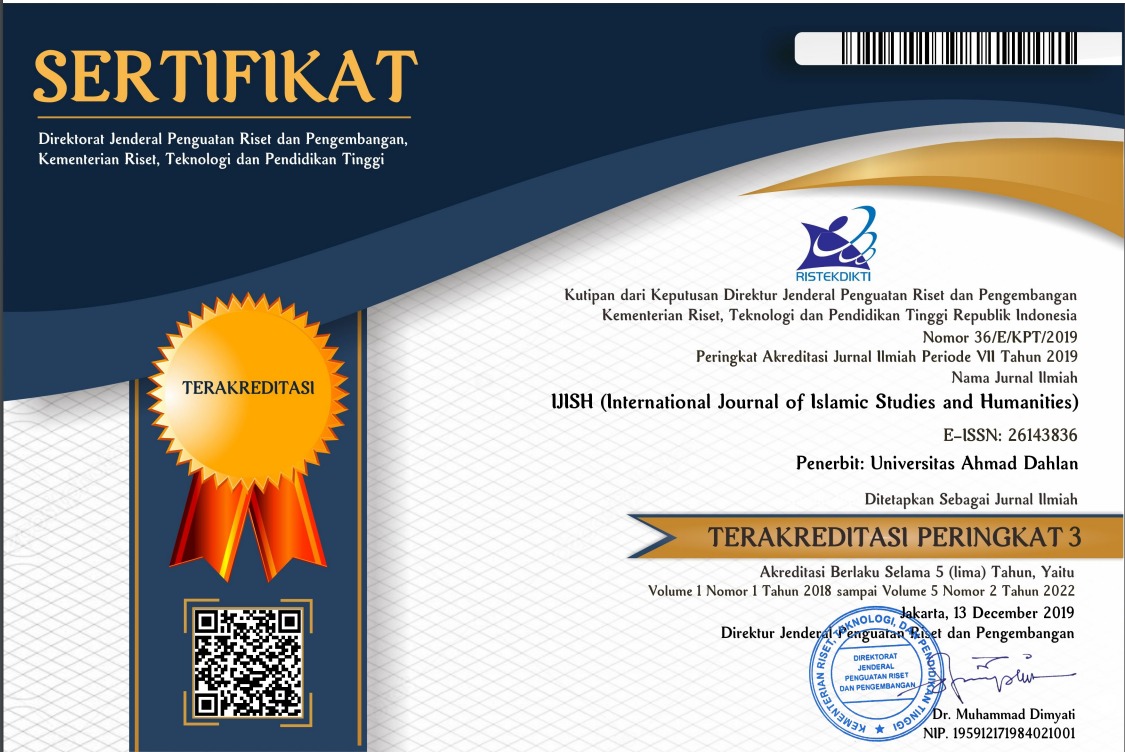Dispersion of Islamic Preaching: some Quranic Viewpoints on the Idea of Tourism
DOI:
https://doi.org/10.26555/ijish.v5i1.3858Keywords:
Islamic preaching, Quranic viewpoint, Tourism, Worship, CommunityAbstract
The spread of Islamic preaching and all efforts towards this direction should be done in their entirety because this represents the nature of Islam itself. As a result, Islamic preaching should be a part of everyday life as a human being, which is not limited to a person's lifestyle. Islamic preaching requires a great deal of man's power of quality and quantity, excellent in spiritual strength, open-mindedness and professionalism. This article seeks to analyze the factors of how the Islamic preaching spread across the globe while making tourism one of the most common mediums for preaching. Using a descriptive qualitative approach and evidence of history, this article reveals the impact of Islamic tourism on the spread of religion on a global scale, as it is crucial to take this result seriously and pay close attention to making Islam the centre of attraction.
References
‘Abd al-Bāqī, M. F. (1945). al-Mu‘jam al-mufahras li alfāẓ al-Qur’ān al-Karīm. Cairo: Dar al-Hadith.
Abdul Basir, A. (2009). Peminjaman kata bahasa Arab dalam bahasa Melayu. In Proceeding of the
Malaysia Conference on Arabic Studies and Islamic Civilization MACASIC (23-30. Bangi:
UKM.
Abdul Rahman, A. (2000). Sejarah dan tamadun Asia Tenggara: Sebelum dan sesudah pengaruh
Islam. Kuala Lumpur: Utusan Publication & Distributor.
Abdullah, I. (1992). Islam di Nusantara: Khususnya di Tanah Melayu. Kuala Lumpur: Jabatan
Perdana Menteri.
Abur, H. U. & Mazlan, I. (2014). Al-Tafsir al-Mawdu’i: Lafaz al-Nafar dalam al-Quran. Bangi:
Penerbit UKM.
al-Buhūtī, M. Y. (1982). Kashshāf al-Qinā‘ min matan al-Iqnā‘. Vol. 1. Beirut: Dar al-Fikr.
Al-Haddad, A. (2001). Sejarah masuknya Islam di Timur Jauh. Jakarta: PT. Lentara Basritama.
al-Qāsimī, M. J. (1994). Maḥāsin al-Ta’wīl. Vol. 4. Beirut: Dar Ihya’ al-Turath al-‘Arabi.
al-Shawkānī, M. A. (1993). Fatḥ al-Qadīr: al-Jāmi‘ bayna fannay al-dirāyah wa al-riwāyah min ‘ilm
al-tafsīr. Vol. 2. Cairo: Dar al-Hadith.
Al-Usairy, A. (2011). Sejarah Islam sejak zaman nabi Adam hingga abad XX. Jakarta: Akbarmedia.
Arnold, T. (1974). The Preaching of Islam: A history of the Muslim faith. London: Constable.
Arnold, T. (1981). Sejarah dakwah Islam. Jakarta: Penerbit Widjaya.
Auni, A. (1991). Islam dalam sejarah politik dan pemerintahan di alam Melayu. Kuala Lumpur:
Nurin Enterprise.
Azizan, B. (1986). Pengenalan tamadun Islam di Andalus. Kuala Lumpur: Dewan Bahasa dan
Pustaka.
Cavanagh, S. (1997). Content analysis: Concepts, methods and applications. Nurse Researcher, 4,
-16. DOI: 10.7748/nr.4.3.5.s2
Creswell, J.W. (2010). Research Design: Pendekatan Kualitatif, Kuantitatif, dan Mixed. Yogyakarta:
Pustaka Pelajar.
Downe-Wamboldt, B. (1992). Content analysis: Method, applications and issues. Health Care for
Women International, 13, 313-321.
Dusuki, A. (1982). Ikhtisar perkembangan Islam. Kuala Lumpur: Dewan Bahasa dan Pustaka.
Elo, S., Kyngäs, H. (2008). The qualitative content analysis process. Journal of Advanced Nursing,
, 107-115.
Fadhlullah, J. (2007). Islam di Asia Barat moden penjajahan dan pergolakan. Shah Alam: Karisma
Publications Sdn. Bhd
Hsieh, H. F., & Shannon, S. E. (2005). Three approaches to qualitative content analysis. Qualitative
Health Research, 15, 1277-1288. https://doi.org/10.1177/1049732305276687
Ibn al-Athīr, A. S. (1979). al-Nihāyah fī Gharīb al-Athār. Vol. 2. Beirut: Maktabah al-‘Ilmiyyah.
Ibn al-Jawzī, J. (1989). Talbīs Iblīs. Beirut: Dar Maktabah al-Hayah.
Ibn Bashrān, A. Q. (1999). Amālī Ibn Bashrān. Riyadh: Dar al-Watan.
Ibn Manẓūr, M. (nd.). Lisān al-‘Arab. Vol. 24. Beirut: Dar Sadir.
Iskandar, A., & Aqbar, K. (2019). Kedudukan ilmu Ekonomi Islam di antara ilmu Ekonomi dan
Fikih Muamalah: Analisis problematika epistemologis. Nukhbatul ‘Ulum: Jurnal Bidang
Kajian Islam. Vol. 5, No. 2 (2019), pp. 88-105. https://doi.org/10.36701/nukhbah.v5i2.77
Leur, J. C. V. (1960). Indonesian trade and society: Essay in Asian social and economic history.
Bandung: Semur Bandung.
Manja, M. L & Ahmad, S. M. N. (1995). Aspek-aspek kesenian Islam. Kuala Lumpur: Dewan Bahasa
dan Pustaka.
Michalopoulos, S., Naghavi, A., & Prarolo, G. (2018). Trade and geography in the spread of Islam.
The Economic Journal, 128(616), 3210-3241. https://doi.org/10.1111/ecoj.12557
Mohd. N. J. (2011). Tamadun Islam & Tamadun Asia. Kuala Lumpur: Sarjana Media.
Muhammad, U. E. (1998). The Muslim society as an information society. In Islam and
Development in Asia Chapter 4 (61-66). Kuala Lumpur: Perniagaan Normah.
Muṣṭafā, I., et. al. (2004). al-Mu‘jam al-Wasīṭ. Vol. 1. Beirut: Dar al-Da‘wah.
Pires, T. (1944). The Suma Oriental of Tome Pires. Nederland: Kraus Reprint Limited.
Reeber, M. (1993). Islamic preaching in France: Admonitory addresses or a political platform?
Islam and Christian-Muslim Relations, 4(2), 210-222.
https://doi.org/10.1080/09596419308721007
Rosni, S & Nurhasma, M. S. (2009). Kesan terjemahan dalam pengajaran Bahasa Arab. In
Proceeding of the Malaysia Conference on Arabic Studies and Islamic Civilization MACASIC
(645-654). Bangi: UKM.
Sayyed, H. N. (1987). Traditional Islam in the modern world. London: KPI Limited.
Schreier, M. (2012). Qualitative content analysis in practice. Thousand Oaks, CA: Sage.
Shihab, M. Q. (1992). Membumikan al-Quran. Jakarta: Mizan.
Smith, J. I. (2005). Da‘wa in the West: Islamic mission in American form. In Mixed Messages:
Materiality, Textuality, Missions (pp. 137-154). New York, NY: Palgrave Macmillan. DOI:
Downloads
Published
How to Cite
Issue
Section
License
Copyright (c) 2022 Abur Hamdi Usman, Mohd Farid Ravi Abdullah, Syarul Azman Shaharuddin, Azwar Iskandar

This work is licensed under a Creative Commons Attribution-ShareAlike 4.0 International License.
Authors who publish with IJISH (International Journal of Islamic Studies and Humanities) agree to the following terms:
- Authors retain copyright and grant the journal right of first publication with the work simultaneously licensed under a Creative Commons Attribution License (CC BY-SA 4.0) that allows others to share the work with an acknowledgment of the work's authorship and initial publication in this journal.Â
- Authors are able to enter into separate, additional contractual arrangements for the non-exclusive distribution of the journal's published version of the work (e.g., post it to an institutional repository or publish it in a book), with an acknowledgment of its initial publication in this journal.
- Authors are permitted and encouraged to post their work online (e.g., in institutional repositories or on their website) prior to and during the submission process, as it can lead to productive exchanges, as well as earlier and greater citation of published work.

This work is licensed under a Creative Commons Attribution-ShareAlike 4.0 International License.






